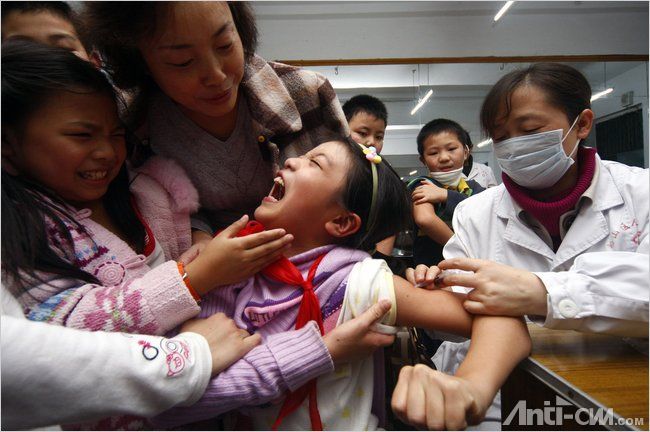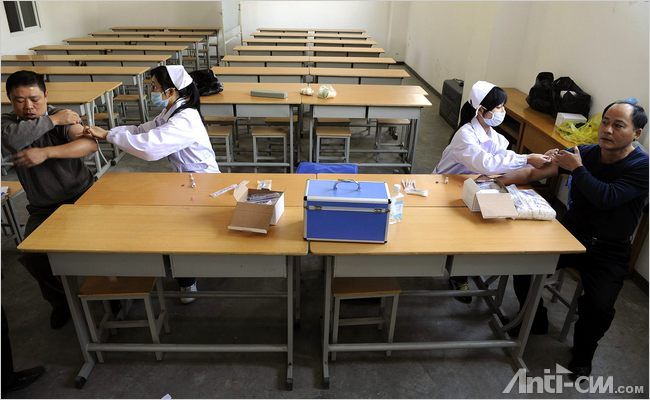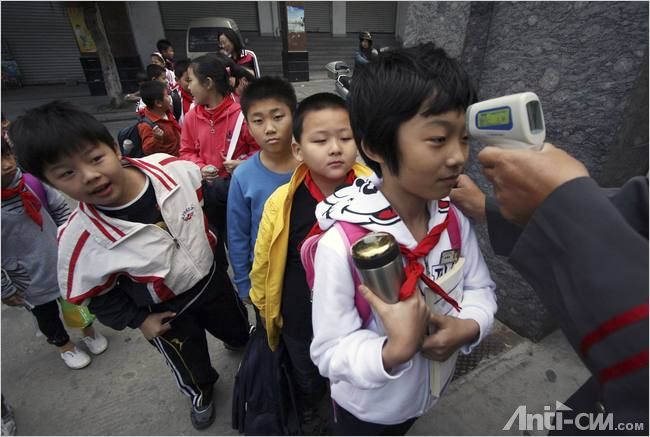本帖最后由 青衣紫萝 于 2009-11-17 19:01 编辑
【中文标题】中国粗暴的流感控制措施似乎有所收效
【原文标题】China’s Tough Flu Measures Appear to Be Effective
【登载媒体】纽约时报
【原文链接】http://www.nytimes.com/2009/11/12/world/asia/12chinaflu.html
【译者】满仓
【翻译方式】人工
【原文库链接】http://bbs.m4.cn/forum.php?mod=viewthread&tid=206592&extra=

星期三,中国四川省绥宁市的一名学生在接受H1N1疫苗注射。

上周,合肥市的流动工人在接受H1N1流感疫苗注射。中国是第一个开展疫苗接种的国家。

上个星期,福建省晋江市一所小学的教师在学校门口检查学生的体温。
译文:
CHANGGANG, China — Few farmers in this southern village gave much thought to the epidemic that had begun spreading rapidly in the United States early this summer until the authorities sealed its 100 residents off from the outside world for about a week. It turned out that a visitor from California had shown symptoms of the swine flu virus, or H1N1, when he arrived for a funeral.
中国长岗——这个中国南方小村庄里的农民几乎没有人对今年夏天在美国迅速蔓延的流行病有过多的关注,直到当局把100名村民与外界隔离了一个星期。事情的起因是一名来自加利福尼亚的游客回到这里参加葬礼时,表现出了猪流感或者H1N1的症状。
Quarantines and medical detentions are among the aggressive measures that Chinese officials have taken to slow the transmission of H1N1, which quickly spread worldwide after being diagnosed first in North America.
自从在北美地区诊断出H1N1之后,疫情迅速在全球范围扩散。中国官员为防止其蔓延,采取了隔离和医疗监禁等激进的手段。
To protests from around the world, China isolated entire planeloads of people entering the country if anyone on the plane exhibited flulike symptoms. Local authorities canceled school classes at the slightest hint of the disease and ordered students and teachers to stay home. China was virtually alone in taking such harsh measures, which continued throughout most of the summer.
来自世界各地的人都是中国的保护对象,如果飞机上有任何人表现出类似流感的症状,整架飞机的人都会被隔离。稍有疾病迹象,当局就会让学校停课,师生回家。中国在孤独而又严苛的疾病控制道路上,整整走过了一个夏天。
Now, Chinese and foreign health officials say that some of those contested measures — more easily adopted by an authoritarian state — may have helped slow the spread of the disease in the world’s most populous country. China has not had to cope with a crush of cases, and it began administering a vaccine for swine flu in early September, the first country to do so.
现在,中国和海外一些医疗官员说,部分有争议的措施——实行这些措施对一个专制国家来说是小菜一碟——或许对延缓疾病在人口最密集的国家传播起到了一些作用。中国没有发生大规模的疾病爆发事件,并且从9月初在全球范围内第一个开始接种猪流感疫苗。
Foreign officials also say that China demonstrated an unusual openness to sharing information about H1N1 with its citizens and other governments, in contrast to its secretive approach to the near pandemic of severe acute respiratory syndrome, or SARS, a few years ago.
外国官员也表示,中国在H1N1事件上,对其公民和外国政府表现出前所未有信息透明度。这与几年前几乎造成全世界范围流行的非典事件中的遮掩态度大相径庭。
That is not to say that China has been spared. On Tuesday, Health Ministry officials reported an “explosive” growth of H1N1 on the mainland because of the onset of winter, with 5,000 new cases in the previous three days pushing the total to more than 59,000.
这也并不是说中国已经完全免疫了。星期二,卫生部的官员报道,由于冬季来临,大陆地区的H1N1病例呈“爆发式”增长。前三天新增病例5000人,总数已经达到59000人。
At least 30 people have died here after contracting H1N1.
已经有30人在感染H1N1后死亡。
Exact data on the virus are hard to pin down; many more cases are suspected than confirmed, and countries often use different methods to identify cases. Still, the indications in China are much more positive than those in India. Like China, India has more than a billion people, many living in poor, rural conditions, and was exposed to the virus after it had been identified in the West. The Indian Health Ministry has reported 505 deaths.
有关病毒的具体数据很难确定,很多病例都只是疑似,而不是确诊,而且不同的国家都在使用不同的方法来识别病例。即使如此,中国的各项指标都比印度要更加令人乐观。同中国一样,印度也有10多亿人口。很多人都住在贫穷的农村,生活环境都到处都是已经被西方确认的病毒。印度卫生部已经报告了505例死亡病例。
The United States, where the virus was spreading before it was identified in the spring, has reported more than two million cases and about 4,000 deaths in a population of 300 million.
今年春天,病毒还未被识别出来时就已经在美国蔓延。人口3亿的美国已经报告了200多万病例,其中4000人死亡。
“I think there were a variety of measures put in place by different countries, and it’s difficult to say what worked best and what didn’t, but China’s has worked very well,” said Dr. Michael O’Leary, the director of the Beijing office of the World Health Organization.
国际卫生组织北京办公室主任Michael O’Leary博士说:“不同的国家采取了各种各样的控制措施,我认为很难说哪种效果最好,哪种效果不好。但是中国的确做得不错。”
As of August, 56 million people had been screened for flulike symptoms at China’s borders, said Feng Zijian, director of the emergency office of the Chinese Center for Disease Control and Prevention. Mr. Feng said he did not know the number of travelers who had been quarantined. The United States Embassy in Beijing said that 2,046 American citizens had been quarantined by the end of October, with 215 testing positive for H1N1.
中国疾病防控中心应急办公室主任冯子健说,8月份有5600万人在中国边境接受了猪流感症状的筛查。他说具体被隔离的游客人数不详。美国驻中国大使馆说,截至10月底,有2046名美国公民被隔离,其中215人被检测出携带H1N1病毒。
“If these strict measures had not been taken, and if there had been a sudden outbreak of the disease, there would have been a huge panic among the Chinese population,” Mr. Feng said. “Although there were many criticisms from outside, people should understand China’s considerations.”
冯先生说:“假如我们没有采取任何严格的措施,那么如果疾病突然爆发,将会在中国境内引起巨大的恐慌。尽管有很多来自外界的批评声音,但是人们应当理解中国的考虑。”
But Mr. Feng and Dr. O’Leary also say that the social and financial costs of China’s tough measures will have to be evaluated to see whether they were worth the benefits. And it is unclear how decisive those actions were in slowing the transmission of H1N1 — the summer heat in much of China was a critical factor in slowing the spread, and most schools were out of session at the time.
但是,冯先生和O’Leary博士也说,中国必须要衡量采取这些措施所花费的社会成本和经济成本,以判断这是否值得。现在很难说这些行动对于抑制H1N1的传播起到了决定性的作用——中国大部分地区夏季炎热的气候是延缓疾病传播的关键性因素,而且当时很多学校都在放假期间。
Some foreign officials are still skeptical of the need for the strict quarantine measures, saying that China should have re-evaluated its policies by June, when it was apparent that the disease was not as lethal as initially feared. The State Council, China’s cabinet, did not decide to relax the quarantine policy until July.
一些外国官员依然对中国的严苛控制措施持质疑的态度,他们说中国应当在6月份的时候重新考虑相关政策,因为疾病并不像当初人们所惧怕的那样具有致命性。但是中国的内阁——国务院直到7月份也没有做出放松隔离政策的决定。
From the beginning, the W.H.O. has said that tightening borders would not keep the disease out, and that closing borders or automatically quarantining specific groups of travelers — as China did for a brief period with holders of Mexican passports — would have no benefit.
从一开始,WHO就表示,收紧边防并不会把疾病拒之门外。还说关闭边境,或者自动隔离某些旅行团不会有任何效果。中国在一段时期内就曾经专门隔离持有墨西哥护照的人。
Quarantines of entire school groups from overseas ignited outrage and led some American officials to complain to Beijing. The State Department implicitly criticized the Chinese policies by issuing travel warnings on the quarantine procedures.
来自海外的一个学校旅行团被整个隔离的事件引发了美国的怒气,一些美国官员开始向北京抱怨。美国国务院通过发布有关隔离措施的旅游警告的方式,含蓄地批评了中国的相关政策。
In July, a group of 65 students and seven chaperons from St. Mary’s School in Medford, Ore., was quarantined twice. The first time came after a girl pulled aside at the airport in Beijing tested positive for H1N1. Then in Henan, a boy running a high fever also tested positive, leading to the second quarantine. During that time, a dozen students tested positive for H1N1. Most of the students and chaperons flew back to the United States on July 31, having spent 12 of 17 days of their trip in quarantine.
7月份,一个来自俄勒冈圣玛丽学校的65名学生和和7名监护人的旅行团被隔离了两次。第一次是因为在北京机场,一个女孩被检测出H1N1病毒呈阳性。后来在河南,一名发高烧的男孩又被检测出H1N1病毒,导致整个旅行团被再次隔离。随后,有10多名学生被查出携带有H1N1病毒。整个17天的行程中,他们被隔离了12天。大部分学生和监护人在7月31日飞回美国。
“At the time, it seemed extreme, and it seemed restrictive, because I had never experienced an infectious disease outbreak,” said Scott Dewing, director of technology at the school and one of the trip chaperons. “Now, looking back and seeing some of the measures that are being taken now in the U.S., the Chinese measures don’t seem so extreme.”
学校的技术部主任、监护人之一Scott Dewing说:“那时候,中国的手段显得很极端,让人觉得受到了限制,因为我从来没有经历过传染性疾病爆发的事件。但是现在,看看美国本土在采取的一些措施,中国的一些行为也不是那么的极端。”
Chinese and Western officials say that Chinese leaders put in place a comprehensive plan for a pandemic outbreak after the disastrous experience of SARS. This includes, at least in the first stages, some of the stringent quarantine measures taken for SARS but also emphasizes education. A red banner hanging from the balcony of a rural school building here in Guangdong Province says, “H1N1 flu is preventable, controllable and curable, and not terrifying.”
中国和西方的一些官员说,在经历过非典的恐怖之后,中国的领导人实施了一个宏大的控制疾病传播的计划。其中包括(至少在第一阶段包括)类似非典那样的严苛的隔离措施,同时也强调了教育。广东省乡下的一所学校的阳台上挂了一面红色的旗子,上面写着:“H1N1可防、可控、可治,不可怕”。
The government was so anxious to stay ahead of H1N1 that officials decided in June to start developing a vaccine even though testing kits for measuring the dosage of the agent in the experimental vaccines had not arrived from the W.H.O., said Zhao Kai, a virologist who advises the government. It was an unusual step, but on Sept. 5 China became the first country to declare that it had developed a vaccine, and by late October it had produced nearly 53 million doses.
政府急于走在疾病蔓延的前面,因此中国的官员们在6月份决定开始研制疫苗,尽管当时还没有收到来自WHO的测量媒介计量的实验设备。滤过性病原体学家赵凯曾经以此建议政府。这并不是常规的流程,但是中国在9月5日率先宣布疫苗研制成功。到10月底,已经生产了5300万支疫苗。
翻译交流:
把粗暴翻译成强硬似乎更符合本意。。。个人愚见。。。
另外,这篇文章中我没有看出太多的攻击,含蓄的表扬倒有。。。反正没那么严重吧
圆月弯刀 发表于 2009-11-14 15:43 
14# 連長
是aggressive,可翻译成积极的
goldjhf 发表于 2009-11-16 16:22 
值得商讨,主意是贬义的。
如果你说一个人很aggressive,没有上下文的话,就是说这个人有攻击性,非常不友好
“1,侵犯的, 侵略的; 好斗的, 挑衅的; 2,有干劲的,有进取精神的;” ...
Felix_de 发表于 2009-11-17 17:42 
|